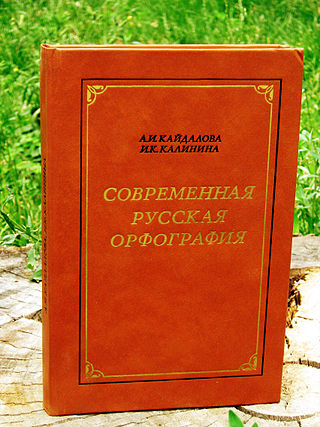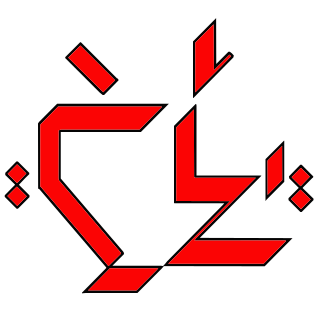The list of Russian language topics stores articles on grammar and other language-related topics that discuss (or should discuss) peculiarities of the Russian language (as well as of other languages) or provide examples from Russian language for these topics.
The list complements the Category:Russian language and does not overlap with it.
The "—" marks articles where the information about Russian language is inadequate or missing.

Bulgarian is an Eastern South Slavic language spoken in Southeast Europe, primarily in Bulgaria. It is the language of the Bulgarians.
Czech, historically also known as Bohemian, is a West Slavic language of the Czech–Slovak group, written in Latin script. Spoken by over 10 million people, it serves as the official language of the Czech Republic. Czech is closely related to Slovak, to the point of high mutual intelligibility, as well as to Polish to a lesser degree. Czech is a fusional language with a rich system of morphology and relatively flexible word order. Its vocabulary has been extensively influenced by Latin and German.
In linguistics, declension is the changing of the form of a word, generally to express its syntactic function in the sentence, by way of some inflection. Declensions may apply to nouns, pronouns, adjectives, adverbs, and articles to indicate number, case, gender, and a number of other grammatical categories. Meanwhile, the inflectional change of verbs is called conjugation.

Kazakh or Qazaq is a Turkic language of the Kipchak branch spoken in Central Asia by Kazakhs. It is closely related to Nogai, Kyrgyz and Karakalpak. It is the official language of Kazakhstan and a significant minority language in the Ili Kazakh Autonomous Prefecture in Xinjiang, north-western China and in the Bayan-Ölgii Province of western Mongolia. The language is also spoken by many ethnic Kazakhs throughout the former Soviet Union, Germany, and Turkey.
Linguistics is the scientific study of human language. Someone who engages in this study is called a linguist. See also the Outline of linguistics, the List of phonetics topics, the List of linguists, and the List of cognitive science topics. Articles related to linguistics include:
Fusional languages or inflected languages are a type of synthetic language, distinguished from agglutinative languages by their tendency to use a single inflectional morpheme to denote multiple grammatical, syntactic, or semantic features.
Chechen is a Northeast Caucasian language spoken by approximately 1.7 million people, mostly in the Chechen Republic and by members of the Chechen diaspora throughout Russia and the rest of Europe, Jordan, Austria, Turkey, Azerbaijan, Ukraine, Central Asia and Georgia.

The Russian alphabet is the script used to write the Russian language. It comes from the Cyrillic script, which was devised in the 9th century for the first Slavic literary language, Old Slavonic. Initially an old variant of the Bulgarian alphabet, it became used in the Kievan Rusʹ since the 10th century to write what would become the modern Russian language.

Sirenik Yupik, Sireniki Yupik, Sirenik, or Sirenikskiy is an extinct Eskimo–Aleut language. It was spoken in and around the village of Sireniki (Сиреники) in Chukotka Peninsula, Chukotka Autonomous Okrug, Russia. The language shift has been a long process, ending in total language death. In January 1997, the last native speaker of the language, a woman named Vyjye, died. Ever since that point, the language has been extinct; nowadays, all Sirenik Eskimos speak Siberian Yupik or Russian.

Russian orthography is an orthographic tradition formally considered to encompass spelling and punctuation. Russian spelling, which is mostly phonemic in practice, is a mix of morphological and phonetic principles, with a few etymological or historic forms, and occasional grammatical differentiation. The punctuation, originally based on Byzantine Greek, was in the seventeenth and eighteenth centuries reformulated on the models of French and German orthography.

The soft sign is a letter in the Cyrillic script that is used in various Slavic languages. In Old Church Slavonic, it represented a short or reduced front vowel. However, over time, the specific vowel sound it denoted was largely eliminated and merged with other vowel sounds.
In linguistics, a grammatical category or grammatical feature is a property of items within the grammar of a language. Within each category there are two or more possible values, which are normally mutually exclusive. Frequently encountered grammatical categories include:

Ithkuil is an experimental constructed language created by John Quijada. It is designed to express more profound levels of human cognition briefly yet overtly and clearly, particularly about human categorization. It is a cross between an a priori philosophical and a logical language. It tries to minimize the vagueness and semantic ambiguity in natural human languages. Ithkuil is notable for its grammatical complexity and extensive phoneme inventory, the latter being simplified in an upcoming redesign. The name "Ithkuil" is an anglicized form of Iţkuîl, which in the original form roughly meant "hypothetical representation of a language." Quijada states he did not create Ithkuil to be auxiliary or used in everyday conversations. Instead, he wanted the language for more elaborate and profound fields where more insightful thoughts are expected, such as philosophy, arts, science, and politics.
Much of Tamil grammar is extensively described in the oldest available grammar book for Tamil, the Tolkāppiyam. Modern Tamil writing is largely based on the 13th century grammar Naṉṉūl, which restated and clarified the rules of the Tolkāppiyam with some modifications.
In linguistics, a feature is any characteristic used to classify a phoneme or word. These are often binary or unary conditions which act as constraints in various forms of linguistic analysis.
Ukrainian grammar is complex and characterised by a high degree of inflection, moreover it has a relatively free word order, although the dominant arrangement is subject–verb–object (SVO). Ukrainian grammar describes its phonological, morphological, and syntactic rules. Ukrainian has seven grammatical cases and two numbers for its nominal declension and two aspects, three tenses, three moods, and two voices for its verbal conjugation. Adjectives agree in number, gender, and case with their nouns.
Central Alaskan Yupʼik is one of the languages of the Yupik family, in turn a member of the Eskimo–Aleut language group, spoken in western and southwestern Alaska. Both in ethnic population and in number of speakers, the Central Alaskan Yupik people form the largest group among Alaska Natives. As of 2010 Yupʼik was, after Navajo, the second most spoken aboriginal language in the United States. Yupʼik should not be confused with the related language Central Siberian Yupik spoken in Chukotka and St. Lawrence Island, nor Naukan Yupik likewise spoken in Chukotka.

In linguistic morphology, inflection is a process of word formation in which a word is modified to express different grammatical categories such as tense, case, voice, aspect, person, number, gender, mood, animacy, and definiteness. The inflection of verbs is called conjugation, and one can refer to the inflection of nouns, adjectives, adverbs, pronouns, determiners, participles, prepositions and postpositions, numerals, articles, etc, as declension.
The Naʼvi language is a fictional constructed language originally made for the 2009 film Avatar. In the film franchise, the language is spoken by the Naʼvi, a race of sapient humanoids indigenous to the extraterrestrial moon Pandora. The language was created by Paul Frommer, a professor at the USC Marshall School of Business with a doctorate in linguistics. Naʼvi was designed to fit moviemaker James Cameron's conception of what the language should sound like in the film. It had to be realistically learnable by the fictional human characters of the film and pronounceable by the actors, but also not closely resemble any single human language.